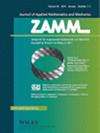非达西多孔介质中具有耗散和辐射传热的倾斜旋转圆盘上的磁流体的频谱模拟
IF 3.2
4区 工程技术
Q1 MATHEMATICS, APPLIED
Zamm-zeitschrift Fur Angewandte Mathematik Und Mechanik
Pub Date : 2023-09-23
DOI:10.1002/zamm.202200395
引用次数: 0
摘要
摘要:本文的研究目的是研究磁场如何影响不可压缩纳米流体在倾斜和拉伸的旋转盘上的非定常流动,而该流动嵌入非达西多孔介质中。此外,传热机理考虑了焦耳加热和粘性耗散。通过施加热辐射来增强对流作用下的传热系统,使本文的研究更具现实性。一组非线性偏微分方程和相关的边界条件定义了这个数学问题。通过适当的相似变换,将数学模型转化为一组具有边界条件的非线性常微分方程,然后采用谱拟线性化方法(SQLM)对其进行数值求解。各种流动参数的图表说明了探索无量纲速度和温度的完整结果。采用回归分析对局部努塞尔数和皮肤摩擦系数进行统计估计。数值结果表明,当磁参数增大时,由于洛伦兹力的作用,径向和切向的流速减小。随着Forchheimer数的变化,流体在两个方向上的流动都随着惯性系数的增大而减小。通过增大磁参量和埃卡特数,流体的温度升高。二次回归分析表明,介质渗透率和产生的洛伦兹力对径向摩擦系数有显著影响,而拉伸参数和Forchheimer数对切向摩擦系数有显著影响。发现热辐射和对流加热对传热系数有显著影响。本文章由计算机程序翻译,如有差异,请以英文原文为准。
Spectral simulation of hydromagnetic flow with dissipative and radiative heat transfer over an inclined rotating disk within a non‐Darcy porous medium
Abstract The goal of the research presented in this paper is to examine how a magnetic field affects the unsteady flow of an incompressible nanofluid over a spinning disc that is inclined and stretched while the flow is embedded in a non‐Darcy porous medium. Furthermore, the heat transmission mechanism takes into account Joule heating and viscous dissipation. By imposing thermal radiation to enhance the heat transmission system under the effects of convection, the current article becomes more realistic. A set of nonlinear partial differential equations and associated boundary conditions defines the mathematical problem. Using an appropriate similarity transformation, the mathematical model is converted into a set of nonlinear ordinary differential equations with boundary conditions, which are then solved numerically by the Spectral Quasi Linearization Method (SQLM). Graphs and tables for various flow parameters illustrate the complete results for the exploration of dimensionless velocity and temperature. Regression analysis is used to statistically estimate the local Nusselt number and the skin friction coefficients. From the numerical results, it is found that when the magnetic parameter is increased, the flow velocity in the radial and tangential directions decreases due to the Lorentz force. With the variation of the Forchheimer number, the fluid flow in both directions decreases with increasing inertia coefficient. By increasing the magnetic parameter and Eckart number, the temperature of the fluid increases. The performed quadratic regression analysis reveals that the permeability of the medium and the generated Lorentz force are significant for the skin friction coefficient in the radial direction, whereas the stretching parameter and Forchheimer number are significant for the skin friction coefficient in the tangential direction. Thermal radiation and convective heating are found to significantly affect the heat transfer coefficient.
求助全文
通过发布文献求助,成功后即可免费获取论文全文。
去求助
来源期刊
CiteScore
3.30
自引率
8.70%
发文量
199
审稿时长
3.0 months
期刊介绍:
ZAMM is one of the oldest journals in the field of applied mathematics and mechanics and is read by scientists all over the world. The aim and scope of ZAMM is the publication of new results and review articles and information on applied mathematics (mainly numerical mathematics and various applications of analysis, in particular numerical aspects of differential and integral equations), on the entire field of theoretical and applied mechanics (solid mechanics, fluid mechanics, thermodynamics). ZAMM is also open to essential contributions on mathematics in industrial applications.

 求助内容:
求助内容: 应助结果提醒方式:
应助结果提醒方式:


